Ethnicity
There is substantial variation in pupil attainment by ethnic group. We use the largest group, White British pupils, as the comparison group, such that the gap for these pupils is set to zero in each year. For each phase we first show a snapshot of attainment (relative to White British pupils) for each ethnic group in both 2019 and 2023. Groups whose attainment fell, relative to White British pupils, between 2019 and 2023 have figures shown in red.
We then show the attainment of both disadvantaged and non-disadvantaged pupils within each ethnicity, relative to non-disadvantaged White British pupils.
Early years foundation stage
At age 5, only four ethnic groups were ahead of White British pupils in 2023, namely Chinese, White and Asian, White Irish and Indian pupils. The gap between White British and both Indian and White Irish pupils narrowed between 2019 and 2023, whilst it widened for Chinese and White and Asian pupils.
Among lower-attaining groups at age 5, two ethnicities stood out as having large gaps compared with White British pupils in 2023: Gypsy Roma pupils (with a gap of 8.3 months in 2023) and Irish Traveller pupils (8.2 months).
Most lower-attaining ethnic groups saw their gaps widen in 2023 compared with 2019, with Black Caribbean and pupils of Any Other Black Background seeing the largest increases, of around 0.8 months. Only Gypsy Roma and pupils of Any Other White Background caught up with White British pupils over the period.
On the whole, the attainment of different ethnicities has converged slightly since 2019, with the standard deviation in gaps reducing by 3 per cent.
Figure E1: Over the course of the pandemic, White British pupils aged 5 have pulled away from most lower-attaining ethnic groups

At age 5 White Irish pupils had the largest gap between the attainment of their disadvantaged and non-disadvantaged pupils, at 9 months. Indeed, non-disadvantaged White Irish pupils had higher attainment than any other non-disadvantaged ethnicity group, whilst disadvantaged White Irish pupils had the third lowest attainment of any disadvantaged ethnicity group.
The next largest disadvantage gap was for White British pupils, at 6 months. Of non-disadvantaged pupils, only White Irish, White and Asian and Chinese pupils were ahead of White British pupils, whilst of disadvantaged pupils all ethnicities but three were ahead of White British pupils.
Chinese pupils had the smallest disadvantage gap of any ethnicity, at just 0.8 months. Correspondingly, disadvantaged Chinese pupils actually had higher attainment than non-disadvantaged pupils of all ethnicities other than White Irish, White British and White and Asian.
Disadvantage gaps for Gypsy Roma and Bangladeshi pupils were also small, at around 1 month. In the case of Gypsy Roma pupils, their non-disadvantaged pupils had lower attainment than that of disadvantaged pupils of all ethnicities other than Traveller of Irish Heritage pupils.
Figure E2: White Irish and White British non disadvantaged pupils aged 5 had higher attainment that most other ethnicities, but also had some of the lowest attainment for their disadvantaged students
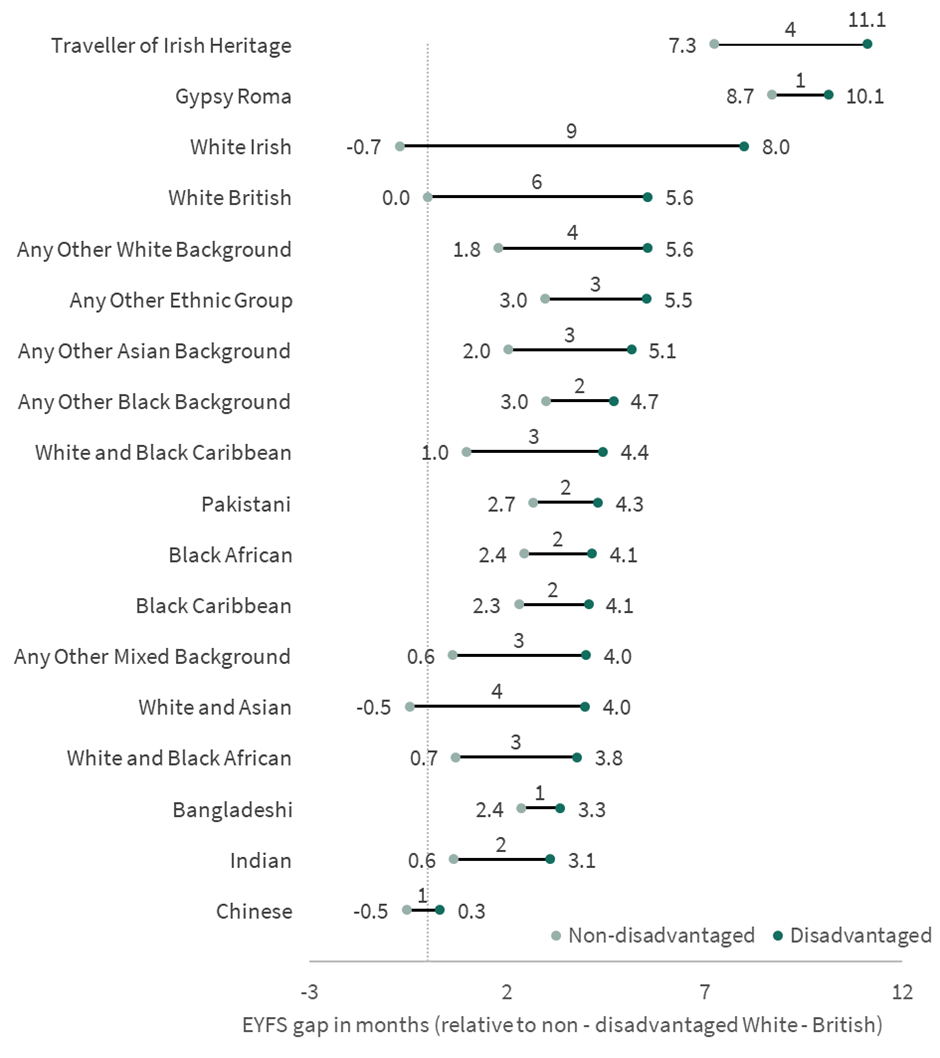
Primary school
By age 11, many ethnic groups had improved their position relative to White British pupils, with only 7 ethnicity groups with lower attainment in 2023, compared with 13 groups at age 5. The high attainment of Chinese and Indian pupils remains notable (ahead of White British pupils by 10.9 and 7.9 months, respectively). However so, too, is the low level of attainment among Gypsy Roma and Irish Traveller pupils, who lagged behind White British pupils by 18.2 and 16.6 months.
When considering changes between 2019 and 2023, 10 ethnicity groups saw improvements relative to White British students (either catching up, or extended their lead) whilst 7 groups experienced a relative decline (fell behind, or reduced their lead). Bangladeshi pupils saw the biggest relative improvement in the gap, by 1.3 months, leaving them almost 4 months ahead of White British pupils. Gypsy Roma pupils also saw a large decrease in the gap, of around a month, though they remain around a year and a half behind White British pupils.
On the whole, the attainment of different ethnicities has changed very little since 2019, with the standard deviation in gaps reducing by 1 per cent.
Figure E3: Over half of ethnic groups saw improvements in the gap at the end of primary school (relative to White British pupils) between 2019 and 2023
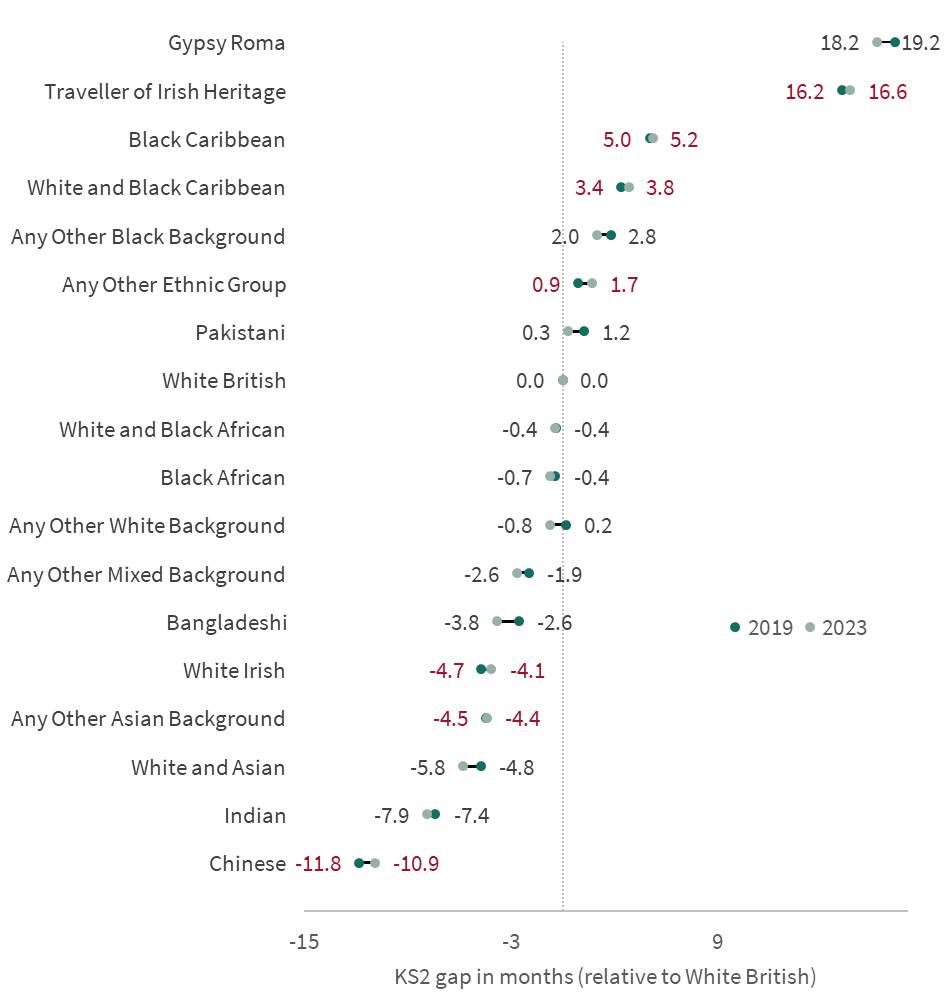
As at age 5, by the age of 11, White Irish pupils had the largest gap between the attainment of their disadvantaged and non-disadvantaged pupils, at 18 months by the end of primary school. Non-disadvantaged White Irish pupils had higher attainment than any other non-disadvantaged ethnicity group other than Chinese and White and Asian, whilst disadvantaged White Irish pupils had the third lowest attainment of any disadvantaged ethnicity group. The next largest disadvantage gaps were for White and Asian pupils at 12 months, and White British pupils, at 11 months.
Chinese pupils had the smallest disadvantage gap of any ethnicity, at just 0.7 months. Notably, disadvantaged Chinese pupils had higher attainment than non-disadvantaged pupils of all other ethnicities.
Conversely disadvantage gaps for Gypsy Roma pupils were also around small, at around 4 months, but their non-disadvantaged pupils had lower attainment than that of disadvantaged pupils of all ethnicities other than Traveller of Irish Heritage pupils.
Figure E4: White Irish, White and Asian, and White British pupils aged 11 had the largest disadvantage gaps, whilst disadvantaged Chinese pupils outperformed even non-disadvantaged pupils from other ethnicities
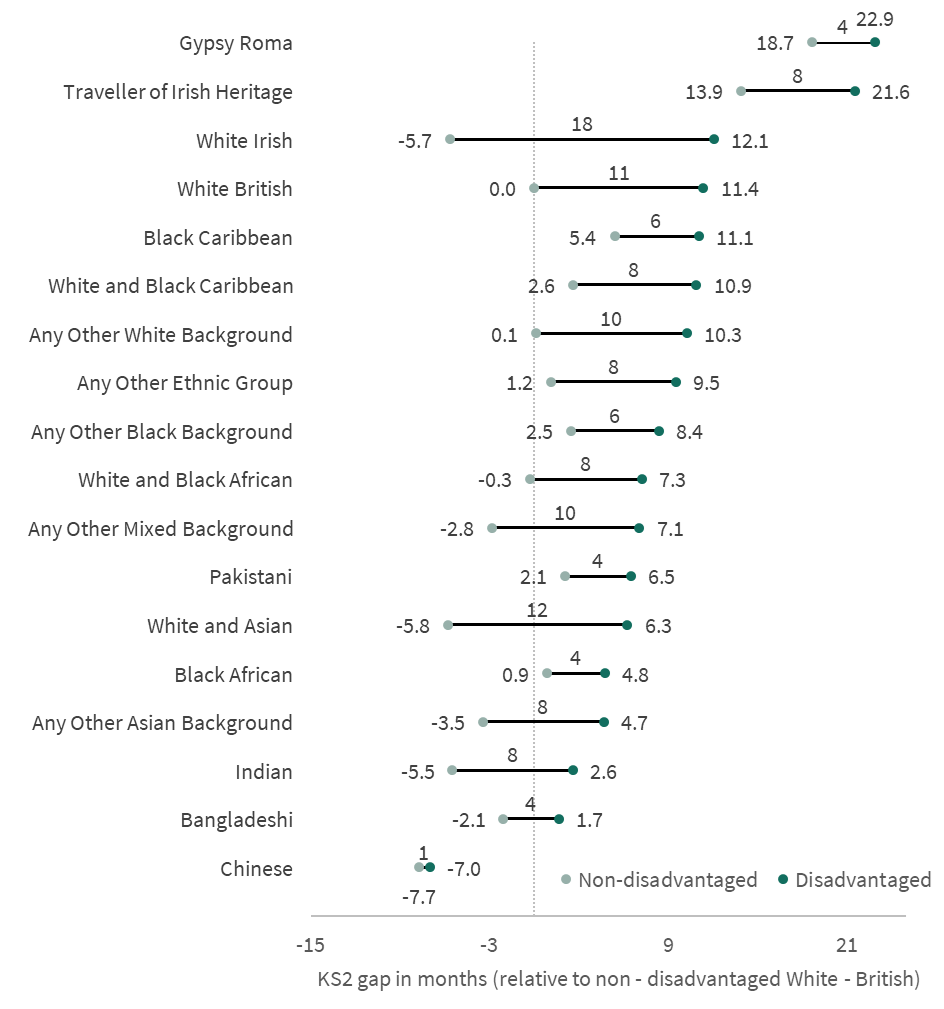
Secondary school
By the end of secondary school, the majority of ethnic groups attained higher GCSE grades than White British pupils in 2023. Except for White and Black Caribbean pupils and White Irish pupils, all other ethnicities saw bigger improvements in attainment between 2019 and 2023 than White British pupils.
Chinese pupils are now over two years (27 months) ahead of white British pupils, eight months ahead of the next higher attaining group, Indian pupils, and almost 5 years ahead of the lowest attaining group, Gypsy Roma pupils. Gypsy Roma pupils are now two and a half years (30 months) behind White British pupils.
Four ethnicity groups also overtook White British pupils between 2019 and 2023; Black – African, Pakistani, Any Other White Background, and Any Other Ethnic group.
Pupils from Any Other Black background saw the largest improvement in their attainment relative to White British pupils between 2019 and 2023, with a reduction in the gap of almost 5 months.
On the whole, the attainment of different ethnicities has converged slightly since 2019, with the standard deviation in gaps reducing by 1 per cent.
Figure E5: Higher-attaining ethnic groups at GCSE have pulled further away from White British pupils since 2019 and lower-attaining groups have generally narrowed the gap, though this has not been the case for White and Black Caribbean pupils
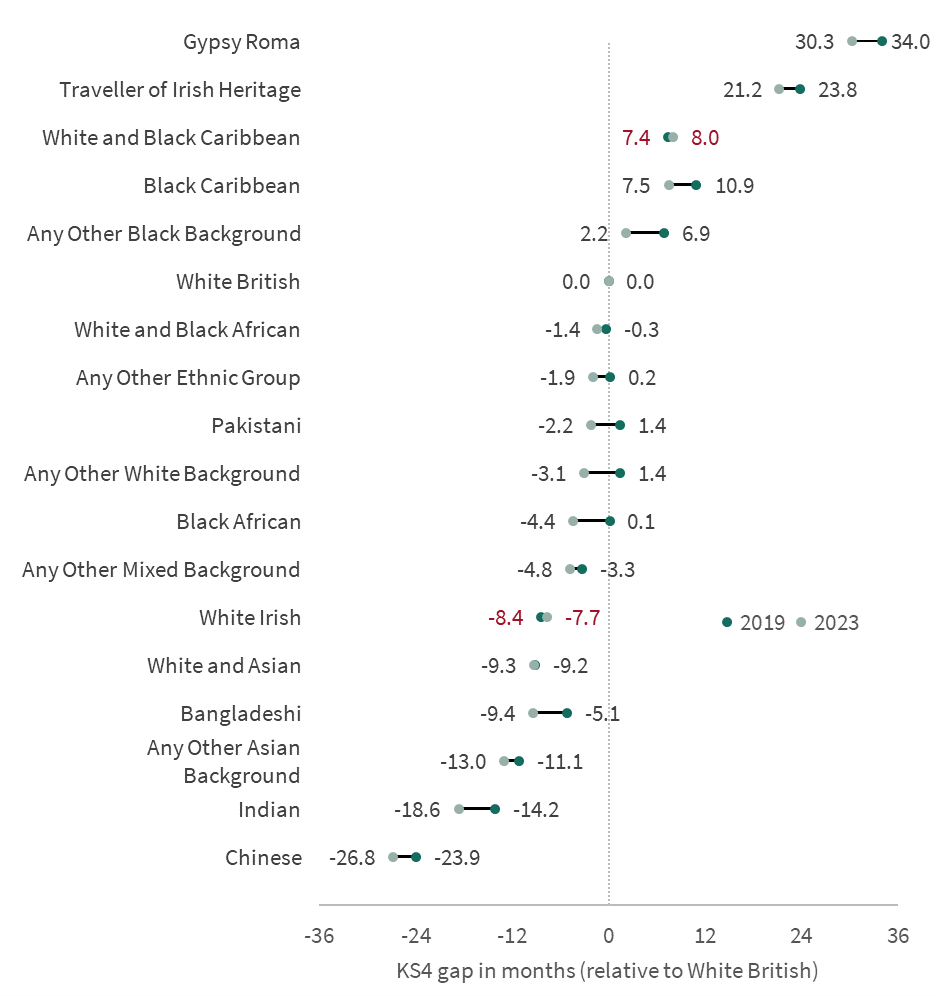
The largest disadvantage gaps within ethnicity groupings were for White Irish pupils (30 months), White British pupils (23 months), and for White and Asian pupils (22 month).
The smallest gap was for Chinese pupils, at just 6 months. Notably, disadvantaged Chinese ethnicity students performed better than non-disadvantaged students from any other ethnicity and 17 months better than the next highest achieving disadvantaged students (Indian pupils).
Conversely Gypsy Roma pupils also had a relatively small disadvantage gap (10 months), but even better off Gypsy Roma students had lower GCSE attainment than disadvantaged students from most other ethnicities (other than Travellers of Irish Heritage).
Figure E6: Disadvantage gaps are particularly large within White Irish, White British, and White and Asian ethnicities
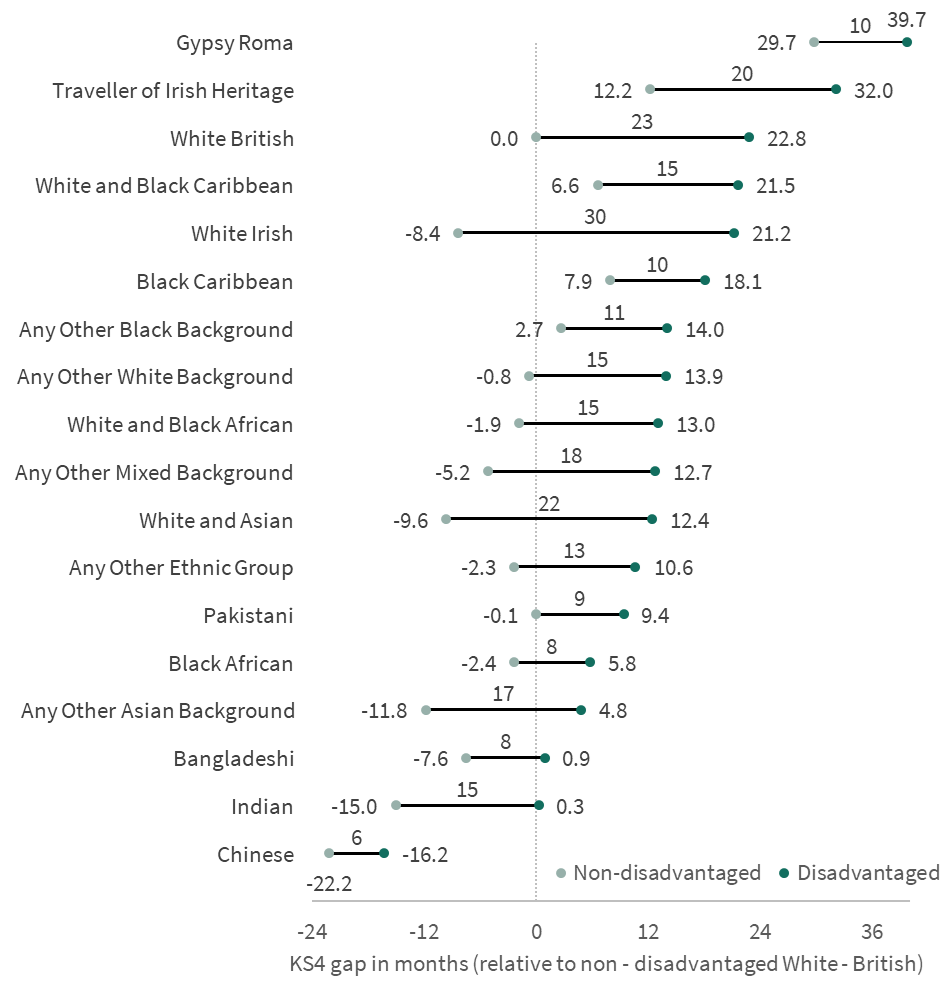
16-19 education
In 16-19 education, students from most ethnic backgrounds achieved more highly across their best three qualifications than White British students in 2023. The exceptions to this were Gypsy Roma students (6.7 grades behind), Travellers of Irish Heritage (5.5 grades behind), Black Caribbean students (1.6 grades behind), White and Black Caribbean students (1.5 grades behind) and those from ‘Any other Black background’ (0.8 months behind). Most of these ethnic groups had a narrower gap relative to White British students in 2023 compared to 2019, and all students that were ahead of White British students (negative gaps) in 2019, had pulled further away by 2023.
Figure E7: Most ethnic groups attained more highly (negative gaps) than White British students and pulled further away since 2019
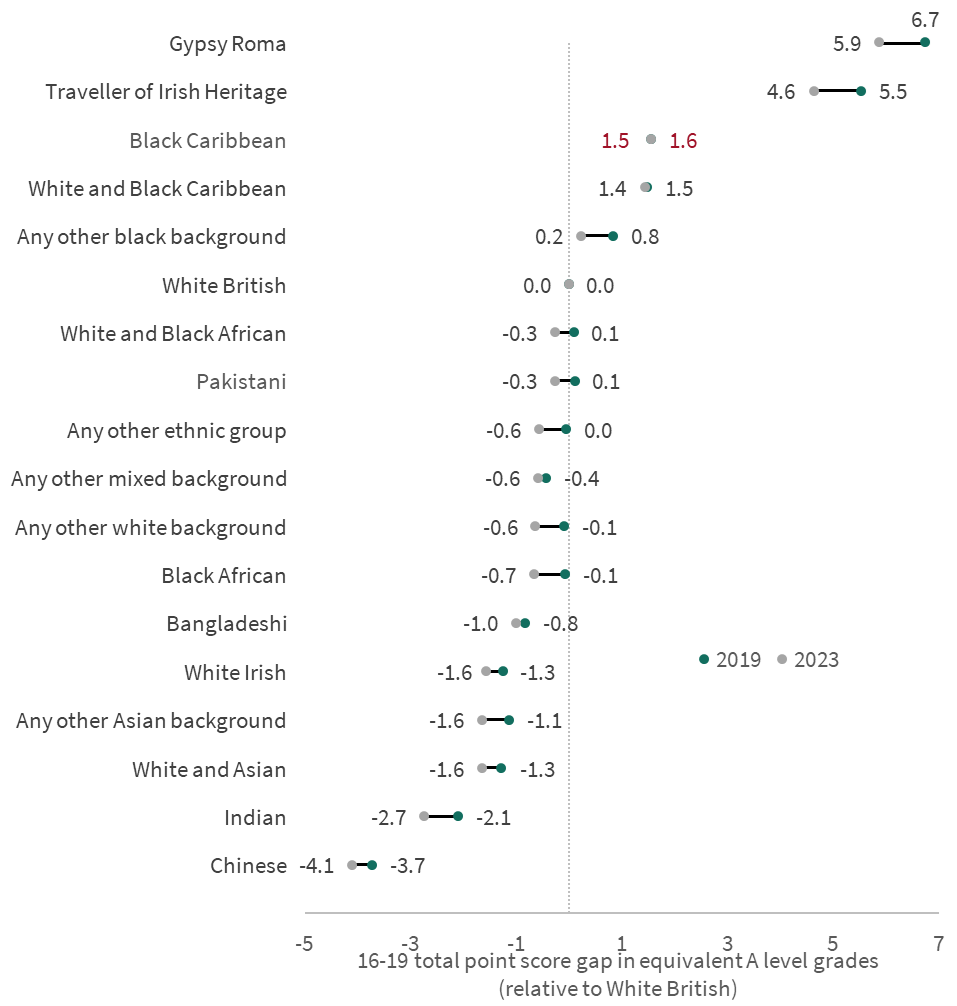
Non-disadvantaged students from most ethnic groups were ahead of non-disadvantaged White British students. Relative to non-disadvantaged White British students, Gypsy Roma and traveller of Irish Heritage students were over 7 grades behinds. In contrast, disadvantaged Chinese students were ahead of non-disadvantaged White British students and 2 grades ahead of the next highest performing disadvantaged group (Indian students).
Figure E8: Disadvantaged gaps were particularly large amongst White Irish and White British students, Travellers of Irish heritage and White and Black African students
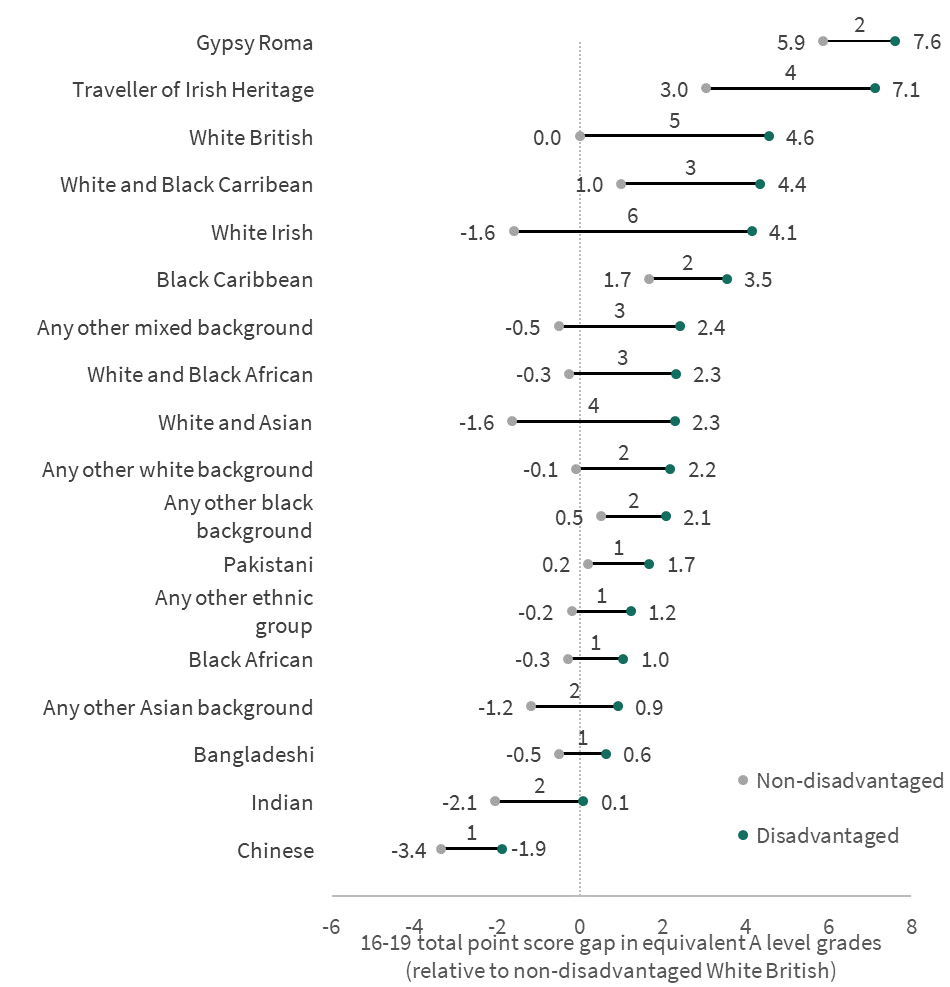
EXECUTIVE SUMMARY geographic disadvantage gaps
